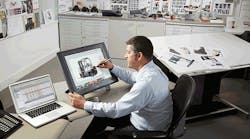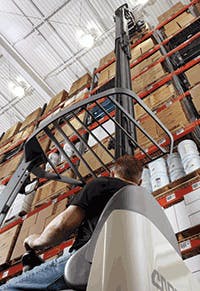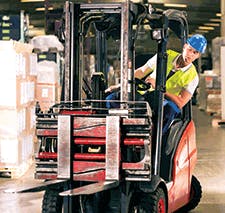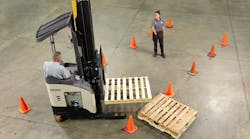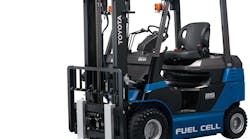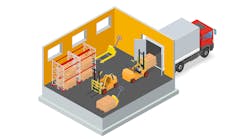As material handling organizations become more sophisticated and interconnected, the purchasing process has evolved to include input from a growing number of individuals. Where there were once only one or two individuals making the decisions, there are now many. Purchasing has become a mindset with influencers representing supply chain, operations, IT, safety and risk management, finance, and purchasing, among others, with each viewing the purchase differently.
When many opinions are involved in the evaluation of a forklift, it becomes tempting to focus on only the spec sheet and other obvious features of the vehicle. It's easy to look at the truck and not see an operator. And this stands to be a crucial oversight. Evaluators should be asking these types of questions:
- Does the truck's design permit sufficient viewing to areas critical for your unique operation?
- What are the anticipated body postures, operational steps, and/or performance levels of the operators who will be driving them?
- Will the truck accommodate operators, or will some operators engage in a compensation strategy, such as excessive reach or lean, to operate the forklift?
- Do contact surfaces, such as armrests, floor mats and seats, provide enough support to help counter the body stresses operators may encounter during a full eight-hour shift?
Don't think these things matter? Your operators will tell you differently—either directly via reports of dissatisfaction, or indirectly via lessened productivity. Strategic design elements are why operators clamor for "their" forklift each shift. It's one reason why they stay in their job and do it more productively than others. And, it's why the forklift decision-making process should be as operator-centric as it is feature-centric.
Design and Design Thinking
The Industrial Designers Society of America (ISDA) defines industrial design as "the professional service of creating and developing concepts and specifications that optimize the function, value and appearance of products and systems for the mutual benefit of both user and manufacturer."
A critical part of this idea is design thinking, which may be best defined as "a systematic approach to problem solving." This is the definition used by authors Jeanne Liedtka and Tim Ogilvie, who wrote Designing for Growth: A Design Thinking Tool Kit for Managers. In this book the authors make the claim, "Design starts with empathy, establishing a deep understanding of those we are designing for."
And they're right. Forklifts in your warehouse must be designed with your operators in mind rather than solely for the function the equipment will provide.
Operator-Centric Forklift Design
Here are some design-based questions to ask your forklift provider before deciding upon a purchase.
Is the visibility appropriate for the tasks the operator will be required to perform?
Visibility is arguably one of the most important considerations during lift truck design. The operator needs good vision to both the travel path and load, as well as to the surrounding environment to facilitate his or her situational awareness. Operators shouldn't need to contort their bodies to view areas critical to a task.
For example, forklifts with variable side-stance operation are often considered to be more efficient for operators who frequently switch between forward and reverse travel. This design permits good posture, stability, and it facilitates quick switching between viewing directions.
One of the most challenging viewing directions is with forks raised as operators manage heavy loads at high heights. In order to help solve this challenge, there are new narrow aisle reach trucks on the market with a single mast that provide notably better load placement visibility at the second level, and improved visibility at nearly all rack levels. In one instance – the Crown RM 6000 – this is due in part to the fact that the mast is offset to the left of the operator and narrows the higher it goes.
How readily will the truck accommodate different body sizes?
The most effective forklift designs will take into account the anthropometry, or dimensional proportions of the human body, to help a wide range of operators perform their job safely, comfortably and efficiently. Forklift designs should enable an operator to reach a control and be encouraged to operate the truck in a manner as intended. The presence of adjustment mechanisms, such as on the seat and armrest, are key to ensuring acceptance within a varying operator pool.
How will an operator's posture impact comfort and fatigue?
Whether operating a forklift or sitting at a desk, posture has a direct relation to fatigue and productivity. It's one reason why Steelcase, a global furniture manufacturer, completed a global posture study of 2,000 people across 11 countries. It's why forward-thinking manufacturers observe forklift operators performing their jobs to identify compensatory behaviors that might affect health or detract from performance. A truly good design should alleviate the desire to deviate from an acceptable posture during the course of a task.
What technology is designed into the forklift to improve productivity and safety?
Perhaps the best way to obtain answers to these questions is to give your operators an opportunity to test the forklift for several days rather than simply reviewing its on-paper merits. Among all of the influencers in the purchasing process, the actual safety and productivity numbers will ultimately be defined by operators' interaction with the truck; therefore, the voice of the operator may be among the most important ones of all the influencers in your purchasing process.
Mike Gallagher is vice president–design with Crown Equipment Corp. (www.crown.com).
